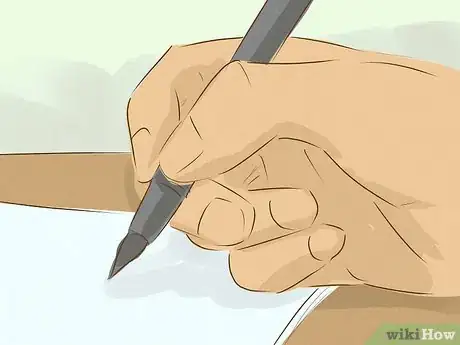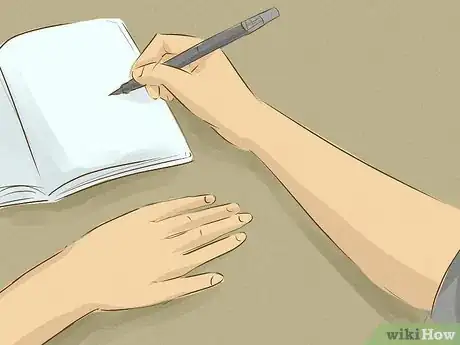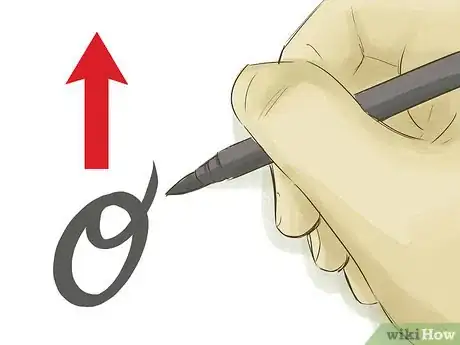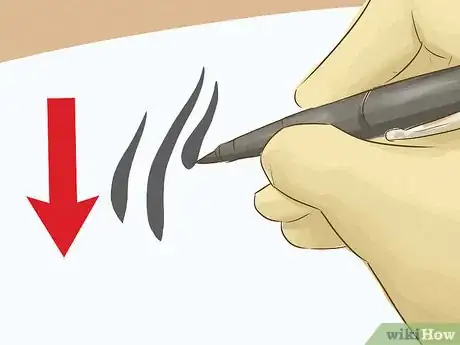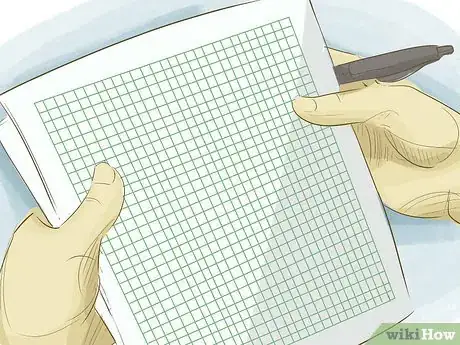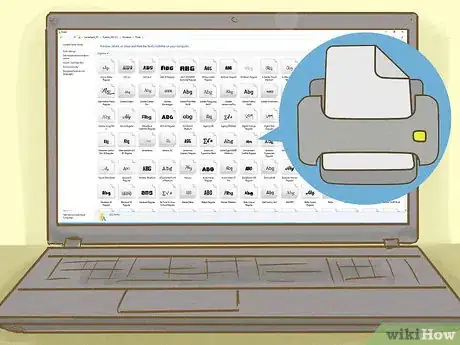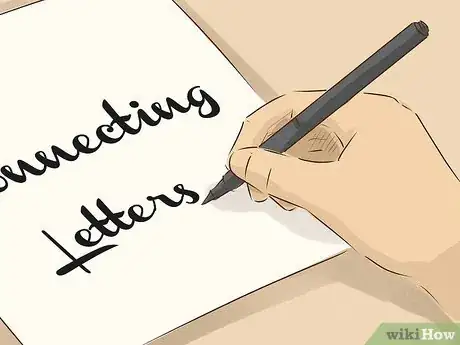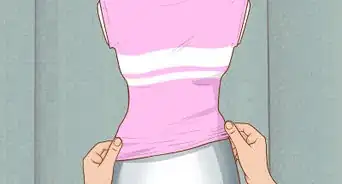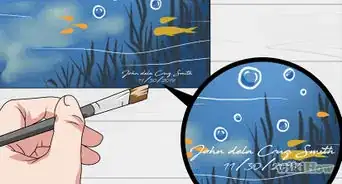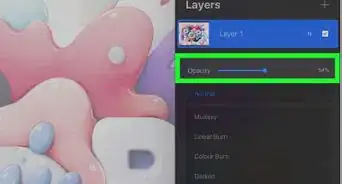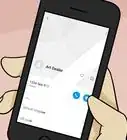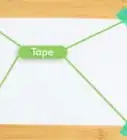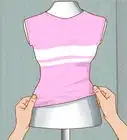This article was co-authored by Kathy Leader. Kathy Leader is an Artist and the Owner of The Art Process. With more than 36 years of art education experience, she specializes in providing mixed media art workshops for individuals and groups. In addition, she works with businesses and organizations to build morale, encourage creative problem solving, and find de-stressing tools. Kathy holds a BFA in Art Education from The University of Cape Town.
This article has been viewed 45,384 times.
Want to learn calligraphy? The brush pen is the artistic tool for you! The brush pen is the perfect writing utensil for controlled, sleek strokes, so it’s a key part of mastering the art of writing fancy letters. In this article, we’ll walk you through everything you need to know about using a brush pen properly. We’ll also provide you with some tips and exercises so that you can practice your brushstrokes. With a little bit of effort, you’ll be crafting elegant and beautiful sentences with your brush pen in no time!
Steps
Holding Your Brush Pen
-
1Hold your brush pen close to the nib. The “nib” of a brush pen is the marker part of the pen. Holding your brush pen right above the nib will give you the most control over your brush pen strokes.
-
2Use your entire arm to keep your script steady and even. Practice keeping your wrist straight and fingers stationary, allowing the motion of your arm to guide your brush pen. When you need to change your application of pressure, let that force come from the strength of your arm—rather than from a change of position or pressure in your fingers or wrist.[3]Advertisement
-
3Trace individual letters of a printed font. Tracing the letters of brush or handwritten fonts printed from your computer will help you get comfortable with using your brush pen to create scripts. You will quickly learn that you must adjust the pressure on your brush pen and its angle to the paper to successfully trace the letters of a font.
- Practicing by tracing a font can also help you develop a consistent style of writing across individual letters, words, and sentences.
Writing with Your Brush Pen
-
1Use “upstrokes” to create thin lines. Prepare to make the upstroke by holding your pen at about a 90 degree angle to the paper. Applying light pressure, draw your brush pen upwards on the paper.[4]
-
2Use “downstrokes” to create thick lines. Prepare to make the downstroke by holding your pen at about a 45 degree angle to the paper. Applying heavy pressure, draw your brush pen downwards on the paper.[5]
-
3Use paper with guidelines to practice writing. As you start writing words and sentences, writing within a designated area will keep your script level across the word or page. You can use lined paper, graph paper, or you can draw your own straight lines across blank pages to make your own guideline paper.[6]
- Think about how much space you need to create crisp strokes and smooth line transitions when buying or making your guideline paper.[7]
- If you want to produce hand-lettering without guidelines but aren’t quite ready to do so, lightly pencil in your guidelines and then erase them after you’re done writing.
-
4Use fonts as a reference for consistent style. As you practice writing with your brush pen, keep a printed font reference nearby. Try to mimic the font you choose to guide the style of your letters and words.
Trying More Advanced Skills
-
1Master the art of connecting letters. Instead of picking your pen up in between letters, give the letters in your words a “tail” that trails out from the letter itself—kind of like connecting cursive letters. Your tail should be a thin brush stroke that you can easily draw up to connect to the next letter in the word you’re writing.[8]
- If you’re having difficulty connecting letters in succession, try giving your letters tails and then going back later to gently make the final connecting stroke between the “tail” and the following letter.[9]
-
2Experiment with creating different fonts. Mastery of brush pen lettering can be evidenced by how many different styles you can letter in. Once you can produce consistent brush pen lettering in one font, find other fonts you like and work on adding these new styles to your repertoire.[10]
- You can revert to tracing printed fonts as a means of easing yourself into writing with your brush pen in new styles.
-
3Learn to create a watercolor effect. You’ll need a plastic surface (a watercolor painting pallet works great) and a water brush in addition to your brush pens. Use your brush pen to deposit ink onto the pallet; then, wet your water brush and use it to pick up some color from the pallet. Finally, “paint” onto your paper with the color on your water brush.[11]
- By adding water, the colors from your brush pens will blend together in the same way that watercolors blend.[12]
Community Q&A
-
QuestionI did all these steps, but my calligraphy is still really bad. What can I do to improve?
 Community AnswerLike anything, calligraphy requires a lot of practice if you want to be really good at it. Keep trying, and if you don't see any improvement after a month or so, maybe calligraphy isn't for you.
Community AnswerLike anything, calligraphy requires a lot of practice if you want to be really good at it. Keep trying, and if you don't see any improvement after a month or so, maybe calligraphy isn't for you. -
QuestionHow can I use a brush pen to draw?
 Community AnswerBrush pens are not really for drawing, but you can use them for small features, such as eyelashes and hair.
Community AnswerBrush pens are not really for drawing, but you can use them for small features, such as eyelashes and hair. -
QuestionWhere can I buy brush pens?
 Community AnswerBrush pens are sold at dedicated arts-and-crafts stores such as Michaels. You may also search for them in the crafts section of any department store.
Community AnswerBrush pens are sold at dedicated arts-and-crafts stores such as Michaels. You may also search for them in the crafts section of any department store.
References
- ↑ http://www.destinationdecoration.com/brush-lettering-i/
- ↑ Kathy Leader. Artist. Expert Interview. 13 February 2022.
- ↑ http://highpulp.com/2014/lettering-basics-brush-pens-pen-pressure/
- ↑ http://www.destinationdecoration.com/brush-lettering-i/
- ↑ http://www.destinationdecoration.com/brush-lettering-i/
- ↑ http://highpulp.com/2014/lettering-basics-brush-pens-pen-pressure/
- ↑ http://highpulp.com/2014/lettering-basics-brush-pens-pen-pressure/
- ↑ http://www.destinationdecoration.com/brush-lettering-ii/
- ↑ http://www.destinationdecoration.com/brush-lettering-ii/
About This Article
To use a brush pen, hold it close to the nib to give you more control over your strokes. Try to keep your wrist and fingers still and move your arm to direct the pen. Use upstrokes and apply light pressure to create thin lines. For thick lines, use downstrokes and apply heavy pressure. If you’re unsure when to use thin and thick lines, print off an online brush or handwritten font guide to use as a reference. You can also practice tracing printed fonts to help you develop a consistent style. For more tips, including how to create a watercolor effect with a brush pen, read on!
